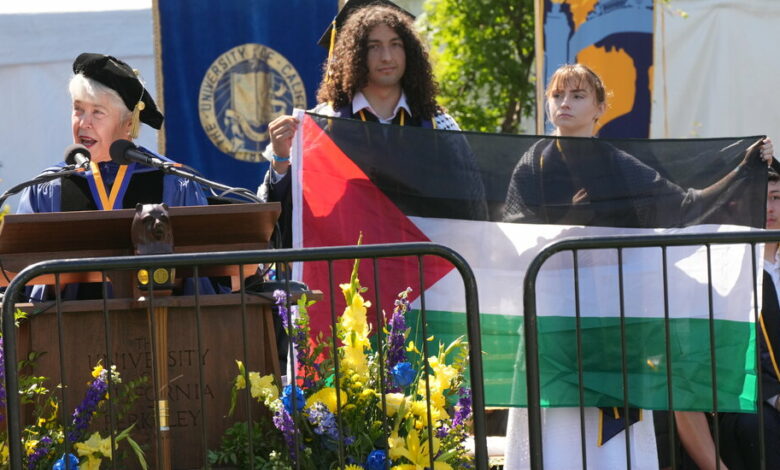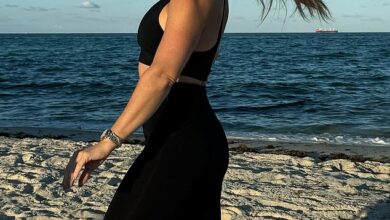The leader of UC Berkeley, a champion of free speech, has advice for today’s students: Show it off

Waves of boos, angry chants and the steady rhythm of feet pounding on metal chairs rocked the graduation ceremony at the University of California, Berkeley.
“Viva, viva Palestine!” students sang. “Hey, hey, whoa, whoa, Israel’s apartheid must go!”
It provided the soundtrack to this year’s anti-war protest, which was carried out on the morning of May 11 by hundreds of graduates in gowns and mortarboards. It was so loud that it almost drowned out the ceremony’s official speakers and the event was halted.
A minute passed.
Two minutes.
Five.
It looked like Berkeley’s 2024 commencement was about to be canceled halfway through.
Then, suddenly and surprisingly, the ceremony resumed.
When it was over and most of the crowd had filed out of the school’s low-ceilinged football stadium, Berkeley Chancellor Carol Christ sat in a folding chair near the stage. She is a silver-haired, soft-spoken octogenarian, soon-to-retire former English professor with an unusual background for a modern university president: Her views on free speech first became clear during her years as a student protester in the turbulent 1960s.
When the protesters forced the break, had she considered ending the event?
“Absolutely not,” Dr. Christ said. This is Berkeley, she said. “We always went through it. Protest is part of our core.”
Dr. Christ (her name rhymes with “wrist”) plans to retire at the end of June. The first woman appointed to the position, she leaves as the oldest chancellor in Berkeley history and one of the oldest leaders of an elite college campus in America.
She first arrived at Berkeley as a professor in 1970, when only 3 percent of faculty members were women, the campus was almost entirely white, and the protest movement that took hold in 1964 had not yet reached its peak.
As her career comes to an end, Dr. Christ has had more time to reflect on the tone and scope of the protest on campus, and she worries about the direction it will take.
Dr. Christ became chancellor in 2017, a year in which conservative firebrands Milo Yiannopoulos and Ben Shapiro caused a stir by announcing lectures on campus. After Mr. Yiannopoulos’ appearance was blocked by what the chancellor called “a riot,” she instituted a year of free speech on campus, complete with additional First Amendment instruction and a faculty-led dialogue committee.
For Mr. Shapiro’s lecture, the price tag for security was about $600,000. But Dr. Christ said protecting a vision that many on her liberal-leaning campus found abhorrent was well worth the cost.
“I started this job during a free speech crisis,” said Dr. Christ, “and I am leaving this job during a free speech crisis.”
This school year, Berkeley has grappled with how to deal with civil disobedience over the war between Israel and Hamas. On college campuses across the country, police crackdowns have led to the arrests of more than 3,000 protesters this spring.
Berkeley came through the protests with only minor police involvement. But the university still saw enough unrest and ugliness to trigger an anti-Semitism investigation by House Republicans and an investigation by the U.S. Department of Education.
Dr. Christ says she has always believed that campuses should reflect the philosophy of John Stuart Mill: “The concept,” she said, “that you need some kind of free marketplace of ideas for the truth to prevail.”
She remains true to the First Amendment’s protections for speech. Yet after seven years at Berkeley, her views have acquired an extra layer of flavor: Mill’s ideals no longer hold water. Not in this time of bitterness and division.
Consider what happened on the Berkeley campus after the October 7 Hamas attacks on Israel.
There was Israel’s daily, direct protest at Sather Gate, one of the main entrances to the campus. There was a clash in a lecture hall as dozens of pro-Palestinian activists broke windows and banged on doors while protesting a speech by a former member of the Israeli army, forcing attendees to evacuate under police protection.
Activists sometimes mocked Dr. Christ in crude terms, saying she had tolerated Islamophobia on campus. Law students disrupted a graduate dinner at the home of Erwin Chemerinsky, the dean of the law school who is Jewish and a Zionist.
The activists had already posted caricatures of him with blood on his lips and holding a fork and knife – which Mr. Chemerinsky, Dr. Christ and many others said reflected an anti-Semitic trope.
A student leader, Malak Afaneh, denied that claim, telling The New York Times: “If our dean had been a Muslim, hijabi-wearing woman who supported genocide, I would have made the exact same poster with the exact same blood.”
Pro-Israel politicians, students, donors and faculty members urged Dr. Christ called for tough action against the activists, accusing them of anti-Semitism. One professor organized a sit-in.
Activists set up nearly 180 tents outside Sproul Hall, famous for its free speech and anti-war demonstrations in the 1960s. It appeared the university would be convulsed by the kind of clashes later seen at Columbia University, Dartmouth College and the University of California, Los Angeles, where school presidents called in police to break up camps.
Dr. Christ, whose office has a framed 1960s photo of Berkeley free speech icon Mario Savio, decided to treat the protests gently, opting for negotiations instead of violence. Shortly after the almost closed graduation ceremony, Dr. Christ in a deal that helped lead to the peaceful closure of the camp.
The students’ long-standing demands include recognition of Palestinian suffering and divestment from companies with ties to Israel.
The Chancellor offered a compromise.
She told activists that Berkeley could not divest on its own. Such decisions rest with the administrators who oversee California’s public university system, and those administrators oppose such a requirement.
But she promised to issue a statement calling for an immediate and permanent ceasefire. And she pledged to support an investigation into Berkeley’s investments to ensure they are aligned with Berkeley’s values, which include, she said, “respect for equality, human rights, a commitment to improving the conditions for human growth and development promote, and an abhorrence of war. .”
The response was swift. Dozens of faculty members signed a letter denies the deal and reprimanding the chancellor for his “appeasement.” A splinter group of protesters ignored the compromise and broke into a closed, fire-damaged university building near the main campus, resulting in at least a dozen arrests.
Even leaders of the student camp laughed at the chancellor’s compromise. “Too little, too late,” said protest spokesman Matt Kovac, who vowed to continue the civil disobedience into the fall.
When asked if he felt like he was in a vice, Dr. Christ nodded and laughed scornfully.
But she said calling in police in riot gear to break up the camp and the Sather Gate protest would not only have been a disaster, but would have been at odds with her school’s cherished identity. And she recalled her own days in the 1960s, when she was a student at Yale protesting the Vietnam War.
“If there was a big demonstration, I was there,” she said, adding: “I wanted to do everything I could to stop the war.”
“Today’s students feel the same moral passion,” she said. “It’s the nature of students at that age. For these students, this feels like the greatest existential crisis of their being.”
“I was once that person.”
At the same time, things are different now, Dr. Christ said, enough to change the nature of what it means to protest and to change her own thinking about free speech.
Social media has damaged nuance and empathy, she noted. Too many people are locked in information rooms, shielded from opposing views and wanting the opposition to be silenced. There is no consensus about the truth.
In recent decades, the most significant protests on her campus have united students, she noted. “Now it’s student against student,” she said. “Faculty member against faculty member. Employee against employee.” And each faction leans heavily on talking over each other.
And then there is the ethics and sensitivity of the current generation, which has grown up with an extra awareness of small and large insults.
Students, she said, “feel that sticks and stones can break my bones and that names can always hurt me.”
To her, John Stuart Mill’s marketplace of ideas seems “less powerful” than ever.
“I’ve come to realize that while freedom of speech is absolute, just because you have the right to say something doesn’t mean it’s right to say something,” she said. “We all use censorship in our expressions in relation to the occasion we are in. If you value your community, you have to find ways to share your views that are not vitriolic, that are not unnecessarily hurtful to other people.”
Right now, she said, “that’s not where we are.”
Unfettered expression carries with it a serious responsibility. That’s why Dr. Christ has been asking students in recent months to reflect on how speeches and protests affected the entire campus community.
Berkeley, she said, should strive to teach students how to have civil dialogue and debate. Without that ability, she said, “we are lost.”
Dr. Christ remembered Mario Savio, who led the free speech movement in Berkeley in the mid-1960s.
During a student rally, a police car was surrounded by student activists near Sather Gate. Savio, the chancellor noted, climbed into the car to give a speech but first took off his shoes to avoid damaging the roof.
Dr. Christ wondered aloud whether a modern-day activist would do the same thing before climbing into a police car. Probably not.
In fact, she said wryly, ‘they might break the windows.’




